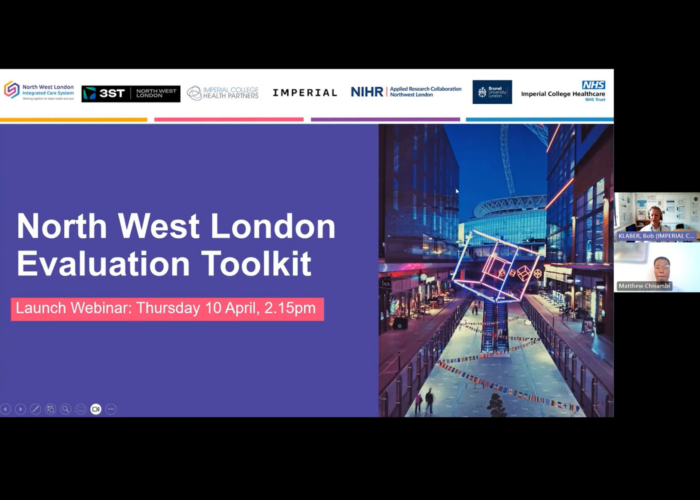 In his blog ‘Taking Population Health Management (PHM) from a ‘buzzword’ to a real enabler for change in primary care’, Henry Ireland, Innovation Manager, discussed the support ICHP can provide to turn the concept of PHM into a reality. Here, Dr Chris Russell, Innovation Delivery Lead, and Lena Woldmann, Innovation Advisor, outline their PHM journey so far with the Bedfordshire, Luton and Milton Keynes Integrated Care System (ICS).
In his blog ‘Taking Population Health Management (PHM) from a ‘buzzword’ to a real enabler for change in primary care’, Henry Ireland, Innovation Manager, discussed the support ICHP can provide to turn the concept of PHM into a reality. Here, Dr Chris Russell, Innovation Delivery Lead, and Lena Woldmann, Innovation Advisor, outline their PHM journey so far with the Bedfordshire, Luton and Milton Keynes Integrated Care System (ICS).
One of the biggest challenges with rolling out a PHM approach across an ICS is building a shared understanding of what PHM actually involves and the roles that each partner can play in its delivery.
In Bedfordshire, Luton and Milton Keynes (BLMK), we’ve been supporting the ICS to design its PHM approach alongside work to develop an integrated health and social care database. The ICS has already been very active in mapping out the area’s resources and gaps, an essential step to delivering PHM, and we’re now supporting them to develop a ‘roadmap’ to PHM implementation.
A clear local picture
To get a closer idea of the ICS’ specific needs in developing PHM, we carried out phone interviews with stakeholders including the local authority, commissioners, and primary and social care. The calls identified some key themes to address, including a general lack of clarity on what PHM is and the need for a shared vision for PHM across different boroughs (also known as ‘places’) within the ICS.
We then arranged two workshops to bring together a wide range of stakeholders including not only clinical staff and commissioners but also partners from the police, Healthwatch and the voluntary sector to improve overall knowledge and confidence in the PHM approach, and to agree a PHM definition and vision for the ICS.
The lack of a common understanding of what exactly PHM is was clear during the first workshop and some attendees said that the amount of data available felt overwhelming, and they often didn’t know which specific data they needed for their purposes or how to understand the information coming from the data.
What PHM means to the BLMK partners
Over the course of the workshop, participants worked on developing a BLMK definition of PHM, which will build on the NHSE definition – “a data-driven approach which includes population segmentation and stratification with the aim to improve population health by designing targeted interventions”. They agreed that their local definition will also include the patient’s perspective on what PHM means for them and emphasise the importance of collaboration between stakeholders across the system.
To define a common vision, workshop attendees were also asked how PHM should be integrated into system working. Areas covered included data infrastructure and business intelligence, collaboration and engagement, quality improvement, information governance, funding, roles and responsibilities, and impact and evaluation.
Moving forwards
In the second workshop, participants agreed on six workstreams that need to be put in place to achieve their goals:
- Information governance
- Workforce: for running the programme ‘on the ground’
- Interoperability and data architecture
- Stakeholder engagement and communications strategy
- Clinical reference group to ensure safe care
- Programme management through a dedicated team.
Short- and long-term goals were identified for each workstream as well as each organisation’s roles and responsibilities for driving the programme over the next three years. Priorities will include gaining more involvement at a primary care network (PCN) level, engaging with the public and primary/community care, making the benefits of a PHM approach clear to frontline staff, and encouraging self-care in the local population.
Key enablers identified include designing common IT systems, making early wins to support buy-in from stakeholders, upskilling data analysts within the ICS partners and aligning the programme to BLMK’s strategic priorities. Key challenges include issues around information governance and competing priorities.
Data isn’t the be all and end all
Part of this work is aimed at creating an integrated care record and BLMK still has to make some key decisions around how that work will progress alongside the PHM programme. But it’s key for ICSs to understand that PHM won’t live or die by access to integrated data, and indeed some areas within BLMK will be able to start population health management using the data they already have, for example all the BLMK clinical commissioning groups will initially be focusing on the frail elderly.
What’s more important than integrated data is having a shared understanding of goals, clinical champions to drive PHM forwards, senior buy-in to address issues around sharing information and – potentially – a willingness among partners to allow the movement of budget so that the most appropriate provider can deliver the right interventions in the right way to the right people, based on the insights from PHM.
Our collaboration with the BLMK ICS highlighted that, only when stakeholders are aligned on a common PHM definition can they form and pursue a shared PHM vision with a collectively owned local narrative to implement PHM (as defined in the NHS maturity matrix for ICSs[1]).
A programme plan is now being developed by the BLMK team and we look forward to continuing our PHM journey together.
Ian Brown, Consultant in Public Health and PHM Lead for BLMK said: “Our work with Imperial College Health Partners has demonstrated the value of taking an inclusive approach to defining what could otherwise be a very technical work programme. PHM solutions will remain on the shelf if they don’t meet the needs and expectations of our professionals and residents, so ongoing stakeholder engagement will be critical to our approach.”
[1] Designing integrated care systems (ICSs) in England. NHS. 2019. https://www.england.nhs.uk/wp-content/uploads/2019/06/designing-integrated-care-systems-in-england.pdf.



